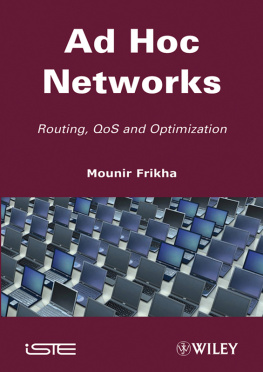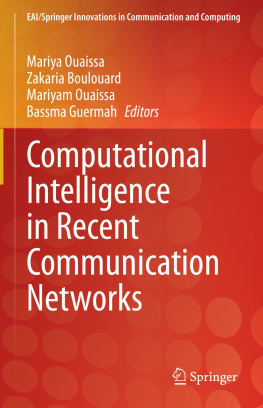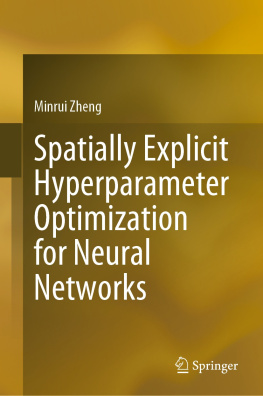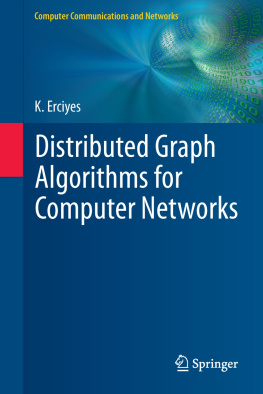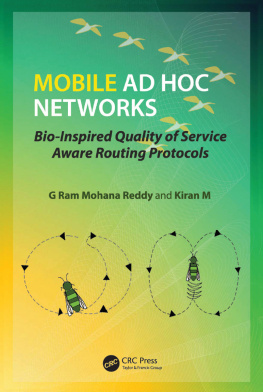Table of Contents
First published 2011 in Great Britain and the United States by ISTE Ltd and John Wiley & Sons, Inc. Adapted and updated from Rseaux ad hoc : routage, qualit de service et optimisation published 2010 in France by Hermes Science/Lavoisier LAVOISIER 2010
Apart from any fair dealing for the purposes of research or private study, or criticism or review, as permitted under the Copyright, Designs and Patents Act 1988, this publication may only be reproduced, stored or transmitted, in any form or by any means, with the prior permission in writing of the publishers, or in the case of reprographic reproduction in accordance with the terms and licenses issued by the CLA. Enquiries concerning reproduction outside these terms should be sent to the publishers at the undermentioned address:
ISTE Ltd
2737 St George's Road
London SW19 4EU
UK
www.iste.co.uk | John Wiley & Sons, Inc.
111 River Street
Hoboken, NJ 07030
USA
www.wiley.com |
ISTE Ltd 2011
The rights of Mounir Frikha to be identified as the author of this work have been asserted by him in accordance with the Copyright, Designs and Patents Act 1988.
Library of Congress Cataloging-in-Publication Data
Frikha, Mounir.
Ad hoc networks : routing, quality of service, and optimization / Mounir Frikha.
p. cm.
Includes bibliographical references and index.
ISBN 978-1-84821-227-5 (hardback)
1. Ad hoc networks (Computer networks) I. Title.
TK5105.77.F75 2011
004.68--dc22
2010042678
British Library Cataloguing-in-Publication Data
A CIP record for this book is available from the British Library
ISBN 978-1-84821-227-5
With recent technological advances in the domain of wireless communications and the emergence of portable computing devices, researchers have turned their attention to improving the function of networks and, in particular, to ensuring rapid access to information independent of time or place.
Until very recently, wireless networks were based exclusively upon planned and sized infrastructures and a hierarchical control of operations. With the vast expansion of wireless applications, particularly personal and local networks, the need for self-organization, independence, adaptability, and cost reduction has become apparent. Mobile ad hoc networks (MANETs) provide a solution that effectively responds to these issues.
The concept of MANETs attempts to expand notions of mobility to all parts of the environment. Unlike networks based on cellular communication, no central administration is available; mobile operators themselves provide a network infrastructure on an ad hoc basis. No supposition or limitation is made regarding the size of the ad hoc network, which can contain hundreds, or even thousands, of cellular units.
In this chapter, we present the evolution from networks with fixed infrastructures to MANET networks. Next, we list the different characteristics of ad hoc networks and give a few examples of their application.
In the past few decades, technological advancements have made major changes to wireless networks, from the techniques used for transmission to the nature of services offered.
With the study of the development of these networks in mind, we begin by presenting the characteristics inherent in wireless communications.
1.2.1. Wireless communications
In general terms, the expression wireless communications refers to communications involving infrared signals or radio frequencies and allowing the exchange of information and resources between the different entities of a network [BAS 04].
Wireless communications vary according to the range and the type of modulation used.
1.2.2. Wireless networks
By the nature of the transmission channel used, wireless networks are distinguished from wired networks by a number of characteristics [BAS 04]:
An unpredictable environment. Interference, mobility, changing channels, and variations in the strength of the signal are all factors that make the network extremely variable.
Unreliable medium. Transmission over a radio channel is prone to errors. Furthermore, interference and the unpredictable quality of links reduce the reliability of the medium. In addition, limited capacity means that the protocols in the transport layer responsible for reliability may not be supported by network nodes.
Limited resources. In the case of mobile nodes, power is supplied by batteries. For reasons of weight and practicality, these nodes have limited storage capacity and limited processing power. Finally, radio channels are a scarce and costly shared resource for which the usage is governed by restrictive regulations:
- the limited size of equipment/tools due to the demands of portability,
- diminished security as the radio interface is shared, and
- dynamic topology.
Wireless networks are considerably more dynamic in nature than wired networks. This is particularly true in the case of mobile networks. From the moment nodes are able to move in and out of the range of other nodes, connections within the network can be cut and others can form.
1.2.3. Classification of wireless networks
Wireless networks can be categorized using various classifications, according to the size of the zone covered, the architecture of the network, or the technique used for access to the radio channel.
1.2.3.1. Classification by type of network architecture
We can distinguish three classes of wireless network according to the level of communication infrastructures used within the network:
Networks entirely dependent on communication infrastructures. In this type of network, a node can only access the network via a communication infrastructure deployed by the network. This infrastructure could be an access point, a wireless bridge, a wireless access router, or a base station transceiver, among other things. The type of network access infrastructure is dependent on various parameters, including the type of application of the network, the range of the network, the envisaged coverage, and the mobility of the nodes.
Networks without a communication infrastructure. From the Latin meaning which goes where it must, ad hoc networks are formed dynamically by the cooperation of a random number of independent nodes. The role of each node is not predetermined and nodes make decisions dependant on the situation of the network without having recourse to a preexisting infrastructure. For example, two PCs equipped with wireless network cards can form an ad hoc network each time one comes into the signal range of the other. As no communication infrastructure is used, a hopping technique is used to access the network. In other words, to communicate with a destination, a mobile node makes use of the other nodes in the network, the message being passed from peer to peer.
Networks making partial usage of communication infrastructures. This type of network is known as a grid network and uses communication infrastructures to allow the wireless network to connect to the Internet. Unlike those networks that use infrastructures exclusively, grid networks do not require a communication infrastructure to be within immediate range of each node. If the node does not detect an infrastructure in its immediate vicinity, it uses the hopping technique to reach one. This architecture combines the two methods of deployment previously discussed and the cost of the communication infrastructure is reduced. It also limits the problems inherent in the usage of hopping. However, problems of overloading can occur in the node immediately next to the communications infrastructure as it receives the accumulated traffic of several of the nodes in the network that it must transmit to this infrastructure.

